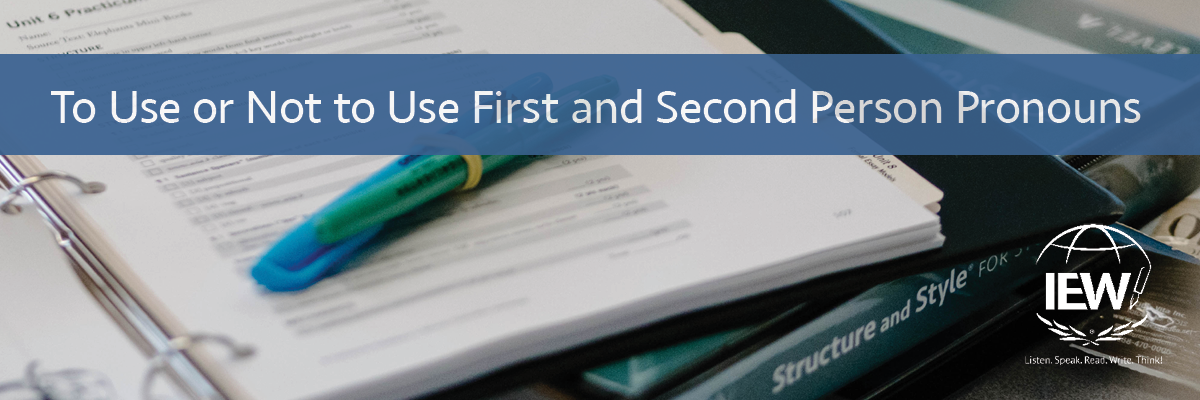
In this paper I will talk about. . . . For some of you, those words sound like fingernails on a chalkboard. Most writing resources tell writers to avoid using first and second person pronouns in formal or academic writing. In fact, IEW’s structural model for Unit 9 contains a large crossed-out I to remind students not to use first person in their essays. The use of first or second person pronouns in research papers or persuasive, argumentative, or analytical essays can make the writer sound biased or the information subjective. First person pronouns (I, me, my, we, us, our) refer to the writer. Second person pronouns (you, your) directly address the audience. Both are considered unprofessional. While the use of first and second person pronouns is discouraged in formal reports and essays, their use is appropriate in other models, and they can be strategically placed in some types of essays for emphasis or interest.
During my tenure as a middle school English teacher, I found students had difficulty listing the three topics in their thesis statements without using the phrase In this essay I will talk about. . . . In their conclusions, they commonly started sentences with In my opinion when explaining the most significant thing about the subjects of their essays. I required them to remove these phrases from their papers. When students inevitably challenged me, I reminded them that the readers knew this was the writers’ opinions since their names were at the top of the papers. Phrases like in my opinion and I believe undermine the authority of evidence and weaken the ethos of arguments.
Using “I” statements, students risk the reader thinking the claims are the students’ opinions or beliefs rather than substantiated reasoning. Writing in my opinion is redundant. Additionally, it basically tells the readers that they can have different opinions. Sentences without “I” statements are more emphatic and present the information with more authority, relying on the strength of the evidence presented to support the author’s claim rather than the author’s opinion. The writer appears more credible.
“You” statements are ambiguous. The word you may refer to the public in general or the reader specifically. Readers might think you refers directly to them and be offended. Rewriting the sentence to identify the intended group, the writer makes a clearer and stronger statement.
When is it appropriate to use first and second person pronouns? Stories are often told in first person. Several selections from IEW Book Recommendations are written from a first person point of view. In Kidnapped, Robert Louis Stevenson described life during the Jacobite rebellion through the eyes of sixteen-year-old David Balfour. Ben and Me by Robert Lawson is a fantasy novel about Benjamin Franklin’s life as seen by his pet mouse Amos. When students use the Story Sequence Chart in Unit 3: Retelling Narrative Stories, they love the opportunity to rewrite it from a different point of view. Using first person, students can tell the story from the perspective of the protagonist, the antagonist, or even as someone who merely watched the action from outside the story. From a different perspective, writers can add extra details, twists, and surprises to make the story uniquely their own.
Since the Unit 7: Inventive Writing structural model can be used to write personal narratives, reflective essays, and even blog posts, using first person to relate personal experiences helps writers connect with their audience by sounding authentic and relatable. In the introduction the purposeful inclusion of a personal anecdote as an attention getter engages the reader. In the conclusion paragraph a carefully crafted command with its understood you serves as a call to action.
Choosing whether to use first or second person pronouns depends on the assignment’s purpose, tone, and audience. First person pronouns can be used to tell stories and convey personal views and experiences while second person pronouns can be used to address and persuade the reader. Both types of pronouns should be used thoughtfully. In my humble opinion, the information presented in this blog post should help you guide your students when to use and not to use first and second person pronouns.
